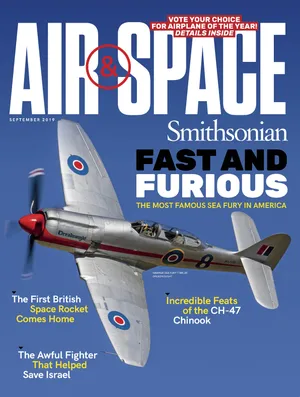At the National Air and Space Museum, a New Gallery Is Being Designed To Be Hands On
From the Director of the Smithsonian’s National Air and Space Museum.
/https://tf-cmsv2-smithsonianmag-media.s3.amazonaws.com/filer/2d/bc/2dbc6466-42a7-414e-87d1-833b13dc1b7a/25a_sep2019_galleryinsiderendering_live.jpg)
The “How Things Fly” gallery in the National Air and Space Museum is the only one dedicated exclusively to learning about STEAM subjects—Science, Technology, Engineering, Art, and Math. Staffed by experienced Museum Explainers—high school and college students who clarify and tell the stories behind the exhibits—the gallery introduces STEAM concepts through demonstrations, hands-on interactives, and design challenges. Now this gallery is about to become an even more engaging educational experience. We have recently received a $10 million gift from Textron to help us reimagine the How Things Fly gallery as part of the multi-year transformation of our Museum on the National Mall.
Aimed at a middle-school audience, the new gallery will feature a more sophisticated design and immersive, interactive experiences created to challenge visitors in STEAM concepts. The big idea we hope young people take away is an understanding of the four forces that guide the design and function of everything that flies.
Highlights of the re-imagined gallery include the AAR Design Hangar. There, visitors will use simple materials, the engineering design process, and their imaginations to find solutions to different air and space-related design challenges. The demonstration theater will offer staff-led demonstrations involving visitors in the exploration of forces affecting things flying in Earth’s atmosphere and beyond.
We are adding a mezzanine level that will serve as a transition from the environment of atmospheric flight to that of space flight. It will offer different vantage points and help our visitors get the most from our activities and engage with each other. Our interactives will invite families and student groups to participate in team learning.
A new Cessna 172 Skyhawk will be the central gallery interactive, giving many visitors their first experience inside a cockpit—the only opportunity to sit inside an aircraft in the entire Museum.
An important part of our transformation is a commitment to telling diverse stories. Woven into the messaging of this gallery will be career stories that we hope speak to every visitor. To fulfill our vision to create a nation of innovators and explorers, we need to widen, not winnow, the field of future aviators. The sky is not limited to a privileged few, and inspiring the next generation of aerospace professionals is the mission of How Things Fly and of our entire Museum.
